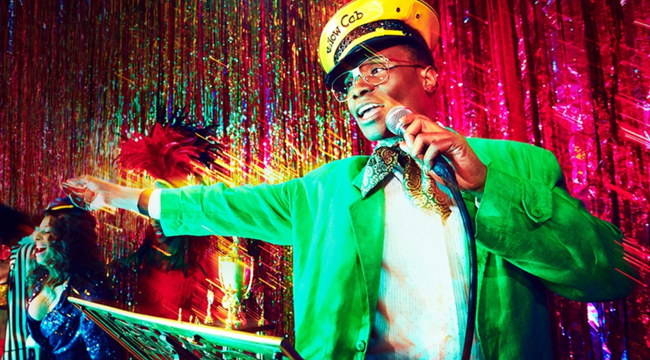
In “Pink Slip,” the penultimate episode of Pose‘s first season (which concluded last night), Stan (Evan Peters) tells his girlfriend Angel (Indya Moore) that he wants to come to a ball and see her life.
“You know what my life is like,” Stan says. “It’s boring. It’s stupid. Every movie, TV show, ad in a magazine shows you what my life is like. Only chance I’m gonna get of understanding your world is if you show me.”
It’s a lovely moment, as the two are falling into a vague sense of normalcy after a rough beginning, and Stan expressing such genuine interest in Angel’s life causes her to visibly light up. But it also doubles as clever self-awareness when it comes to Stan and Pose as a whole. Stan is a white man who can’t go five minutes without seeing his own life reflected back in media; Angel is a trans woman of color who, in all likelihood, has never seen a positive depiction of herself in media — if she’s seen any depiction at all. Pose understands this imbalance in representation. It’s why queer and trans people of color are at the forefront of the show while the white men (including Peters, James Van Der Beek, and Christopher Meloni) are relegated to the sidelines, so rarely there that I often forgot about them for long stretches of time while watching the show.
It’s the opposite of what we’re used to — majority straight and/or white casts with tokenized characters occasionally thrown in — and it’s part of what makes Pose, as many reviews pointed out, “remarkable” or “revolutionary.” For once, those words are right on the money, not just because of the cast (which features five trans actresses, boasting “the largest number of transgender actors in series regular roles for a scripted series“) but also because of the behind-the-scenes representation. Yes, even more remarkable is that Pose bucked the typical conventions of queer and trans narratives by spending its first season committed to showcasing joy, strength, and community over trauma and tragedy.
Too frequently, these stories consist of a coming out narrative or endless trauma (or, in a lot of cases, both) but Pose — which takes place in the late ’80s — is most often a lively, spirited, and joyous affair. The idea of family and community is on full display, the characters are multi-dimensional people written as more than just their trans-ness, and the ballroom scenes are positively enthralling (providing a nice counterpart to the seminal 1991 documentary Paris Is Burning). Pose doesn’t shy away from the harsh realities of being a member of the LGBTQ+ community in the ’80s (and, sadly, not a lot has changed) so its episodes do include transphobia, rejection, a lot of ignorance from side characters, and the looming AIDS crisis — but none of that was its sole focus or its end game.
Instead, Pose used the traumatic moments to strengthen the bonds between the main characters; it turned it into fuel for them to want to win the trophy, yes, but also to want to have fun. A great example is found in the season finale: when emcee Pray Tell (Billy Porter) discloses his status to a date, he’s expected to be rejected but instead his date accepts the news, accepts him, and they kiss. Pray Tell’s reality isn’t ignored, but it isn’t used for melodramatics, either. There are plenty of LGBTQ+ narratives that want to make audiences cry. Pose episodes make you want to dance.
This success is not only attributed to the importance of casting trans actors in trans roles but also the importance of having trans writers and directors. It’s notable that Ryan Murphy (co-creator along with Brad Falchuk and Steven Canals) stepped aside to instead let trans writers Our Lady J (Transparent) and Janet Mock (an author who made her TV writing and directorial debut with Pose) take more control of their own stories.
In an insightful interview with ScreenCrush’s E. Oliver Whitney, Mock expanded on why Pose focuses more on hope than trauma: “I think that’s one of the strange things that gets missed when straight people, and/or straight cis people make stories about us. Because they miss that nuance. All they see us is through the prism of their own ideas of us being victims, and traumatized.” She then remarks on how it’s important that Pose shows the “resilience” of her community and explains, “I think it could only happen on a series where we’re centered. We’re not the sidekicks. We’re not on the margins looking in. We are the inside.” The lived-in experience brings necessary care, specificity, and authenticity to the series. It’s not an outsider looking in, but people showing their own lives to outsiders — and knowing exactly which parts to share.
There’s a difference between superficial diversity and real representation, and fortunately more series are starting to lean toward the latter — resulting in truly fantastic television. Starz’s Vida created one of the most accurate depictions of queer Latinx communities by filling the room with queer and/or Latinx writers (and employing plenty of women in all aspects of production). Netflix’s One Day At A Time introduced a non-binary character with the help of one of their genderqueer writers. Amazon’s (unfortunately canceled) One Mississippi used its all-female writers room to craft an important, realistic depiction of sexual harassment. Though it’s becoming more common for people who aren’t straight, cis, and/or white to see themselves on television, they’ve still had to see depictions that were written from outside perspectives. But these shows, and especially Pose‘s wonderful first season, are allowing them to own their stories — and own their joy.






